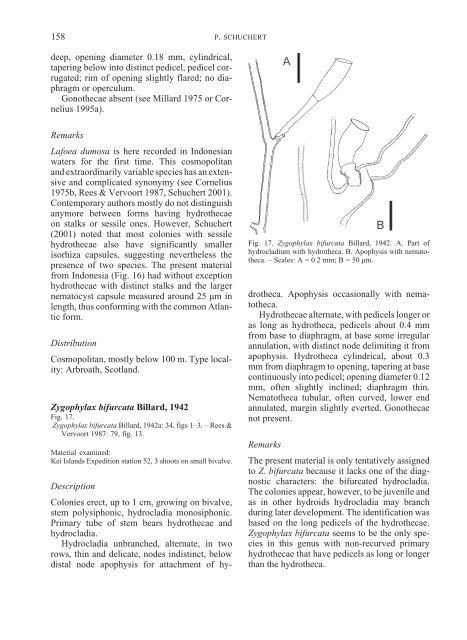Hydroids (Cnidaria, Hydrozoa) of the Danish expedition to
Hydroids (Cnidaria, Hydrozoa) of the Danish expedition to
Hydroids (Cnidaria, Hydrozoa) of the Danish expedition to
Create successful ePaper yourself
Turn your PDF publications into a flip-book with our unique Google optimized e-Paper software.
158<br />
deep, opening diameter 0.18 mm, cylindrical,<br />
tapering below in<strong>to</strong> distinct pedicel, pedicel corrugated;<br />
rim <strong>of</strong> opening slightly flared; no diaphragm<br />
or operculum.<br />
Gono<strong>the</strong>cae absent (see Millard 1975 or Cornelius<br />
1995a).<br />
Remarks<br />
Lafoea dumosa is here recorded in Indonesian<br />
waters for <strong>the</strong> first time. This cosmopolitan<br />
and extraordinarily variable species has an extensive<br />
and complicated synonymy (see Cornelius<br />
1975b, Rees & Vervoort 1987, Schuchert 2001).<br />
Contemporary authors mostly do not distinguish<br />
anymore between forms having hydro<strong>the</strong>cae<br />
on stalks or sessile ones. However, Schuchert<br />
(2001) noted that most colonies with sessile<br />
hydro<strong>the</strong>cae also have significantly smaller<br />
isorhiza capsules, suggesting never<strong>the</strong>less <strong>the</strong><br />
presence <strong>of</strong> two species. The present material<br />
from Indonesia (Fig. 16) had without exception<br />
hydro<strong>the</strong>cae with distinct stalks and <strong>the</strong> larger<br />
nema<strong>to</strong>cyst capsule measured around 25 µm in<br />
length, thus conforming with <strong>the</strong> common Atlantic<br />
form.<br />
Distribution<br />
Cosmopolitan, mostly below 100 m. Type locality:<br />
Arbroath, Scotland.<br />
Zygophylax bifurcata Billard, 1942<br />
Fig. 17.<br />
Zygophylax bifurcata Billard, 1942a: 34, figs 1–3. – Rees &<br />
Vervoort 1987: 79, fig. 13.<br />
Material examined:<br />
Kei Islands Expedition station 52, 3 shoots on small bivalve.<br />
Description<br />
Colonies erect, up <strong>to</strong> 1 cm, growing on bivalve,<br />
stem polysiphonic, hydrocladia monosiphonic.<br />
Primary tube <strong>of</strong> stem bears hydro<strong>the</strong>cae and<br />
hydrocladia.<br />
Hydrocladia unbranched, alternate, in two<br />
rows, thin and delicate, nodes indistinct, below<br />
distal node apophysis for attachment <strong>of</strong> hy-<br />
P. SCHUCHERT<br />
Fig. 17. Zygophylax bifurcata Billard, 1942. A. Part <strong>of</strong><br />
hydrocladium with hydro<strong>the</strong>ca. B. Apophysis with nema<strong>to</strong><strong>the</strong>ca.<br />
– Scales: A = 0.2 mm; B = 50 µm.<br />
dro<strong>the</strong>ca. Apophysis occasionally with nema<strong>to</strong><strong>the</strong>ca.<br />
Hydro<strong>the</strong>cae alternate, with pedicels longer or<br />
as long as hydro<strong>the</strong>ca, pedicels about 0.4 mm<br />
from base <strong>to</strong> diaphragm, at base some irregular<br />
annulation, with distinct node delimiting it from<br />
apophysis. Hydro<strong>the</strong>ca cylindrical, about 0.3<br />
mm from diaphragm <strong>to</strong> opening, tapering at base<br />
continuously in<strong>to</strong> pedicel; opening diameter 0.12<br />
mm, <strong>of</strong>ten slightly inclined; diaphragm thin.<br />
Nema<strong>to</strong><strong>the</strong>ca tubular, <strong>of</strong>ten curved, lower end<br />
annulated, margin slightly everted. Gono<strong>the</strong>cae<br />
not present.<br />
Remarks<br />
The present material is only tentatively assigned<br />
<strong>to</strong> Z. bifurcata because it lacks one <strong>of</strong> <strong>the</strong> diagnostic<br />
characters: <strong>the</strong> bifurcated hydrocladia.<br />
The colonies appear, however, <strong>to</strong> be juvenile and<br />
as in o<strong>the</strong>r hydroids hydrocladia may branch<br />
during later development. The identification was<br />
based on <strong>the</strong> long pedicels <strong>of</strong> <strong>the</strong> hydro<strong>the</strong>cae.<br />
Zygophylax bifurcata seems <strong>to</strong> be <strong>the</strong> only species<br />
in this genus with non-recurved primary<br />
hydro<strong>the</strong>cae that have pedicels as long or longer<br />
than <strong>the</strong> hydro<strong>the</strong>ca.

















